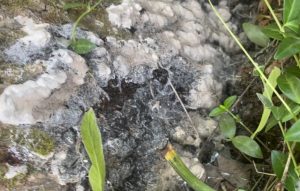
I wasn’t too familiar with this fungus until recently when I found it at a client’s house on a linden tree. The fungus attacks European beech, red maple, Norway maple ; it less commonly attacks oak, hackberry, apple, and the linden. Kretzschmaria can be conspicuous and appear to be of little worry. The wood around the base can look unaffected, making the pathogen hard to notice. However, it is quite aggressive, breaking down lignin and cellulose. But, unlike white rot fungi, cellulose is targeted during the decay process. As it decays, the infected wood tissue rapidly loses strength. However, the wood can still appear relatively good because of the pattern of decay it exhibits. Starting in the roots and spreading to the base, the fungus causes rot at the lower trunk. The biggest issue I see with Kretzschmaria is that the tree can look totally fine. It can also develop cankers and get falsely identified as Phytophthora.
The pathogen appears as gray, fruiting bodies with white margins in late spring to early summer. From a distance, it looks kind of like paint near the base because it’s mostly flat. A closer look reveals a more lumpy texture. Over time, it becomes darker, and sort of blends in with the tree. The fruiting bodies are mostly at the very base of the tree, but in more advanced stages it may be higher on the trunk.
Lastly, there really isn’t anything to do to prevent the pathogen. However, it is suggested that in the event a tree is removed because of it, it’s wise to grind and get rid of the stump as much as possible. Otherwise, the fungus will persist and possibly spread to nearby roots of other plants. If you spot something that you think could possibly be Kretzschmaria, call an arborist to confirm. Even though the tree may appear fine, it could be something that needs attention sooner than later. The following pics are of an American Linden I took a look at recently.




